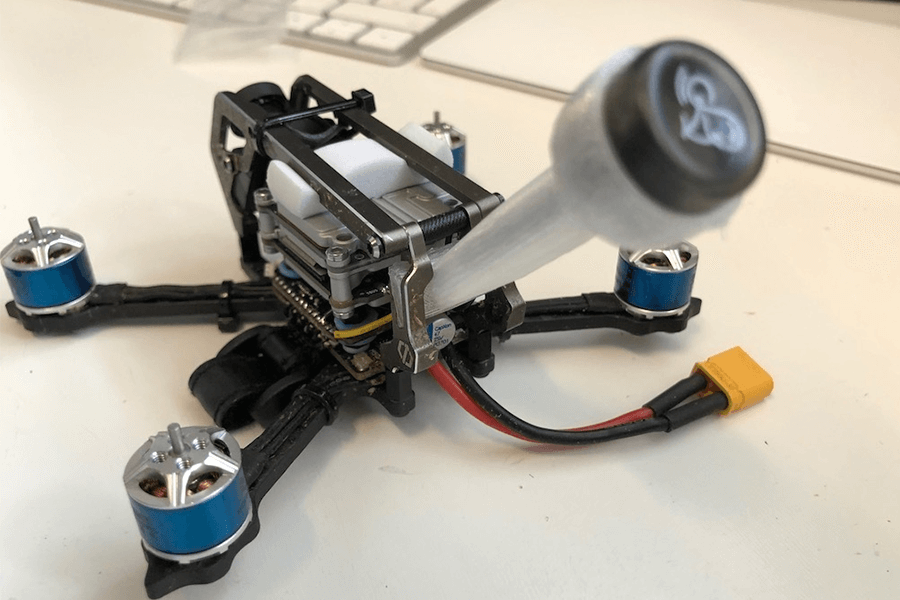The most underrated FPV component, in my opinion, is the drone antenna. However, wireless communication between the radio and radio receiver, or the video transmitter and video receiver, would not even be imaginable without antennas. I’ll show you how to select the ideal one for your FPV drones in this article.
What is an FPV Antenna?
An FPV antenna is necessary for all radio equipment to operate. Your smartphone, in case you were unaware, also contains many antennae.
A component used to transform electrical video signals into radio signals and broadcast the signal is an FPV antenna. Additionally, it takes in airborne radio signals and changes them back into electrical visual signals. Both the FPV video transmitter and video receiver have FPV antenna mounted. Both VTX and VRX cannot function effectively without antennas.
The active element, coaxial cable, and connector are the three components that make up an FPV antenna. The active element is the essential element for radio transmission and reception; a connector is necessary to connect your VTX or VRX; whereas the coaxial cable only connects the two.

How Does an Antenna Work?
A transmitter antenna and a receiver antenna are required for anything wireless. Wi-Fi, Bluetooth, and other wireless technologies on our smartphones all have a transmitter antenna and a reception antenna.
A transmitter antenna and a receiver antenna are equivalent in quadcopter. But it matters what kind is utilized on the transmitter and receiver.
In our example, transmitter antennas pick up the video signals and transform them into radio waves, which are electromagnetic radiation. By oscillating back and forth, antennas perform the task of transforming electrical signals into electromagnetic radiation.
The receiving antenna decodes this transmitted signal and turns the radio waves back into electrical impulses. Therefore, the effectiveness of the video transmission directly depends on the FPV antenna.
Understanding FPV Antenna
Directional vs Omnidirectional Antenna
The two main classifications of antennas are omnidirectional and bidirectional. Although their methods of operation are relatively similar, the signal’s transmission method varies greatly.

Radio waves are broadcast by directional antennas in a beam that is typically 120 degrees or smaller. Therefore, the receiving antenna does not receive any signals if the transmitting antenna is not in the 120° receiving region, which is more like a focused flashlight beam.
However, omnidirectional antennas transmit in all directions, more like a light bulb, so that no matter where or how the transmitting antenna is positioned, the receiving antenna always receives a portion of the video signal that, in some cases, is sufficient to steer your quad out of trouble.
A helical antenna is typically used for long-range quads when there is little variation in the orientation of the transmitting and receiving antennas. Contrarily, patch antennas are used to pick up signals when the quad is directly in front of you and within the 120° range.
Different Types of FPV Antenna
Monopole Antenna
A monopole antenna is a style of FPV antenna that makes use of a ground plane, which is a conductive surface, positioned perpendicularly over a straight rod-shaped conductor. Since they provide a focused emission pattern, monopole antennas are frequently chosen for point-to-point communications. They are well-known for withstanding wind and rain as well as being able to handle strong radio frequencies.

Dipole Antenna
Two identical conducting components, such as metal wires or rods, are frequently found in dipole antennas. Receiving antennas are powered by the driving current from the transmitter or by the output signal from the receiver. Both a current flow in wires or rods receives the driving current. The force created by this current flow works to keep the two rods or wires together.

Patch Antenna
A patch antenna is a low-profile antenna that can be mounted on a surface. It is composed of a flat sheet or “patch” of metal, metal foil, or plastic that can be any geometric shape, including triangular, oblong, and rectangular.
It can transmit and receive signals thanks to its omnidirectional radiation pattern. In the military and commercial aviation sectors, patch antennas and cellular and satellite communications are frequently employed.
Key Features of FPV Antenna
Antenna Polarization
Antenna polarization comes in two flavors: linear and circular. How their separate waves propagate in terms of radiation pattern is the primary distinction between linear and circular polarization. A wave is projected along a single plane, either vertical or horizontal, via a linear antenna. Because the wave is only travelling in one direction, this kind of polarization makes it possible to transmit more energy. The difficulty a linear wave has navigating around an object that is in its plane of propagation, however, reduces the penetration of obstacles. A corkscrew-shaped wave that periodically spirals through both the vertical and horizontal plane is emitted by a circularly polarized antenna.
Left hand circular polarization and right hand circular polarization are the other two categories of circular polarization. Consider LHCP and RHCP as being analogous to a screw’s thread. A circularly polarized antenna transmits radio waves that typically rotate either clockwise (right) or counterclockwise (left) as they go in the direction of the receiving antenna. Only other RHCP antennas and vice versa may properly capture signals generated by RHCP antennas.
Antenna Gain
The range and coverage angle of a directional antenna are indicated by antenna gain. It measures the difference in power between an antenna and an isotropic radiator, which is a hypothetical antenna that radiates evenly in all directions. In terms of antenna gain, decibels, or dB, are used.
In general, a higher gain results in a narrower beam width but a longer range. The radiation pattern can be changed by antenna gain, as shown in the antenna’s datasheet. In order to achieve better coverage everywhere around the drone, you should use drone VTX antennas with lower strength that are omnidirectional. To get the best of both worlds from VRX antennas, you should combine low gain omni-directional and mid/high gain directional antennas. It’s also acceptable to utilize low gain omni-directional antennas on your video receiver if you don’t travel long distances.
Remembering that every 3 dB gain from your antenna is equivalent to tripling the power of your transmitter when working with decibels is important. For instance, switching to a new antenna with a 200mW video transmitter and achieving a 6dB gain is similar to switching to an 800mW video transmitter, which can double your range! (6dB = 3dB plus 3dB = two doublings = 4x, or 200mW x 4 = 800mW).
Frequency
FPV antenna is always tuned to a certain radio frequency. For radio links and video links, respectively, 2.4GHz and 5.8GHz are the two most frequently utilized frequencies in quadcopter. The number of wavelengths a wave oscillates across in a second is measured in hertz (Hz; unit: Hz). Imagine a slinky being extended and violently shaken from left to right. A portion of the slinky will shake regularly as it moves down its length, rising and falling before starting the cycle all over again. One wavelength is the distance between two crests and peaks. When long-range flight is a priority, lower radio frequencies, like 915MHz, are frequently employed for radio control and video transmission.
Factors to Consider When Choosing FPV Antenna
Receiver Antennas and Transmitter Antennas
Antennas can be designed to do both transmitting and receiving. It’s critical to select the appropriate antenna for each task. Use an omnidirectional antenna on your video transmitter for dependable performance. This is due to the fact that the quadcopter is constantly spinning and moving, making it difficult to maintain a directional antenna pointed at the pilot’s video receiver.
Since you can direct your antenna in a specific direction, you can utilize a highly directional antenna on your video receiver. The best of both worlds can be achieved when you combine directional and omni-directional antennas using a diversity receiver on your goggles.
Antenna Connectors
There are two main categories of antenna connectors: RP-SMA (reverse polarity SMA) and SMA (sub-miniature version A). The RP-SMA connector has a male and female connector, just like the SMA connector does. Therefore, it’s crucial to pay attention to the connector on the VTX.

The antenna connector should be the matching female if the VTX has a SMA male connector. The RP-SMA connectors operate in a similar manner.
The MMCX (Micro tiny coaxial) type connector is one of the more recent connector types that manufacturers are using increasingly frequently. The reason for the rising popularity is that MMCX connectors include a rotating, swiveling head that relieves the strains placed on VTX connectors.
Weight and Durability
An antenna can weigh anywhere from 1 g to more than 10 g. Each gram counts when creating something that weighs less than 250 g. Smaller weights, such as those of U.FL connection and linear polarization, may be more comfortable for you.
Particularly those circularly polarized antennas, antennas are brittle. If drone racing or freestyle is your primary objective, you should search for ones with enhanced crash protection.
Install
Install the VTX Antenna
The most crucial things to remember while mounting your VTX (video transmitter) antenna are to keep it away from any conductive materials and use a rigid antenna. Depending on your flying style, there are different ways to position your VTX antenna. Your FPV drone may be 20 to 30 degrees forward tilted if you cruise most of the time. The best antenna position is to have your antenna mounted slanted back so that it is facing vertically while in flight. FPV VTX antennae are frequently installed within a 3D printed TPU mount for racing drones as protection. Long-distance flight may not be best served by this, though. A more basic introduction to FPV VTX antennae is available here post:
Install the Receiver Antenna
The sort of setup you have must be taken into account when installing the video receiver antenna. A directional and an omni-directional antenna are indicated for diversity configurations for overall better performance, whereas a circularly polarized omni-directional antenna is advised for single antenna receivers. It’s standard procedure to mount your video receiver module on a ground station when flying a long distance in order to avoid unforeseen changes in antenna orientation brought on by movements of the pilot’s body. To make sure the patch antenna is pointed in the appropriate direction, a spotter can also assist with antenna adjustment. When the signal deteriorates, if your goggles contain a patch antenna, you might try turning your head to face your model.


